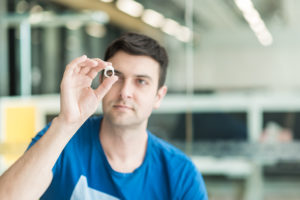
A revolutionary wearable tracking device which re-trains insomniacs to get a better night’s sleep at home has been developed by a Flinders University scientist.
Techniques previously used in laboratory sleep retraining have been replicated in the new device, called Thim, to help people learn to fall into a longer, deeper sleep pattern.
Invented by renowned sleep psychologist Emeritus Professor Leon Lack, the small lightweight device is worn on a person’s finger and connects wirelessly to a smart phone app to determine when the person is awake or asleep.
Just as the person dozes off, the Thim device gently wakes them in this initial lightest sleep stage by vibrating and repeats the process each time the person dozes off again.
Professor Lack and Thim US-based company founder Ben Olsen will today launch a fundraising campaign to fast-track commercial production of the device through crowd-funding platform Kickstarter. They hope to start production within the next six months and have the device – which will cost around AUS$199 – available in May next year.
Professor Lack said research showed that by creating a situation where people repeatedly dozed off helps the body learn to fall asleep again faster, while also increasing sleep duration by an hour.
“The development of Thim is based on 10 years of university research which has shown a better and drug-free way of improving sleep. For the first time, Thim allows our research to be translated into the home environment,” said Professor Lack, also the inventor of the acclaimed Re-Timer light therapy device, now sold world-wide.
As well as a ‘sleep retraining mode’, Thim also features a ‘power-nap’ module to help people on the go achieve optimum benefit from having a day-time nap. Users can also see their sleep patterns on their smart phone and track progress.
“The secret of the perfect power nap is to sleep for exactly 10 minutes. Sleeping for more than 20 minutes will leave you feeling groggy upon waking, and sleeping for five will provide no benefit,” Professor Lack said.
“Because Thim knows when you’ve fallen into the first and lightest stage of sleep to the minute, it knows when to begin timing your perfect 10-minute power nap. The best option you have now is setting your alarm, which doesn’t know when you fall asleep.”
“We’ve re-invented the wearable for sleep. This device has the potential to benefit so many people around the world, and from our own research we know that is works,” Professor Lack said.
Find out more and support the Thim campaign here.
Thim’s developers are also responsible for the Flinders University developed Re-Timer glasses, one of the greatest international success stories in innovative sleep technology.

